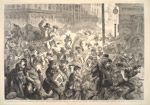The Great Conflagration
It was like a snowstorm only the flakes were red instead of white.
Fire Narrative of Bessie Bradwell Helmer
Besides the fact that the Great Chicago Fire started around nine o'clock on Sunday evening, October 8, 1871, somewhere in or very near the O'Leary barn, the exact particulars of its origin are unknown. But given the dry summer and the heedless way the city had been built and managed in regard to its vulnerability to fire, a kick from a cow would have been sufficient but by no means necessary to burn Chicago down. As A. T. Andreas, the city's leading nineteenth-century historian, put it, "Nature had withheld her accustomed measure of prevention, and man had added to the peril by recklessness."
Fires were a common occurrence in Chicago, and there were several in the week before the fire. The largest of these by far began on Saturday night. And firemen might have been able to contain the great conflagration that began the following evening but for a series of technological and human failures in the alarm system. The fire, driven by a strong wind out of the southwest, took dead aim on the center of the city. It divided unpredictably into separate parts by hurling out flaming brands on the superheated draft it generated, leaping the South Branch of the Chicago River. Dividing yet again, it made short work of Conley's Patch. By 1:30 it reached the Court House tower, from which the watchman barely escaped. When city officials realized that the building was doomed, they released the prisoners from the basement jail just before the great Court House bell, which had been sounding the alarm, plummeted through the collapsing tower.
As thousands fled to the North Division, the fire pursued them. By 3:30 a.m., the roof collapsed on the Pumping Station at Chicago Avenue, effectively rendering any firefighting efforts hopeless. By noon on Monday the North Division fires had reached North Avenue and then continued the better part of a mile to Fullerton Avenue. Back in the South Division, the luxurious new Palmer House gave way, along with the offices of the Chicago Tribune, whose editors had exhorted the Common Council to raise the level of fire protection or face disaster. Tuesday morning a rain began to fall, and the flames finally died out, leaving Chicago a smoking, steaming ruin.
As the fire expanded and advanced, the mood of the population shifted from interest and concern to alarm and panic. Many heard the Court House bell and saw the red and amber flames in the distance but thought little of what was they believed was a commonplace but containable hazard. Individuals who worked in downtown buildings that were supposed to be "fireproof," like the one that housed the Tribune, and people understandably attracted by the spectacle, walked to positions from which they could monitor the fire's progress. Before long, however, they realized that there was no place of guaranteed safety. Fascinated as well as fearful, people alternately--even simultaneously--tried to get the best vantage and flee for their lives with what little they could salvage, creating havoc in the streets and wild crowding on the bridges crossing the river. Husbands and wives, parents and children, were separated. It seemed as if the ground was itself on fire--which in fact it was, since the streets, sidewalks, and bridges were made of wood. Even the river seemed vulnerable, as several vessels and grease along the water's surface ignited.
Later there were reports of Chicagoans trapped or crushed in their homes, on one of the bridges, or in the Washington and LaSalle Street tunnels, the latter of which had just opened on Independence Day. Along with the stories of narrow escapes, heroic rescues, and selfless mutual assistance, there were also tales--no doubt exaggerated but with some basis in fact--of looting and drunkenness, as well as of outrageous demands and outright thievery by those who had been hired to cart goods to safety. "'Pay as you go' had become the watchword of the hour," recalled one of the refugees. "Never was there a community so hastily and completely emancipated from the evils of the credit system."
The burned-out gathered in dazed and dispirited groups on open stretches of prairie west and northwest of the city, in the South Division along Lake Michigan, in the North Division's Lincoln Park, and along "the Sands," a patch of lakeshore just north of the Main Branch of the Chicago River. In such places of refuge, Chicagoans who heretofore had little contact with each other were unceremoniously forced together. As a fire history put it, one could find "Mr. McCormick, the millionaire of the reaper trade, and other north-side nabobs, herding promiscuously with the humblest laborer, the lowest vagabond, and the meanest harlot." Once they settled themselves, there was little they could do but bear witness to this calamity beyond comprehension.








